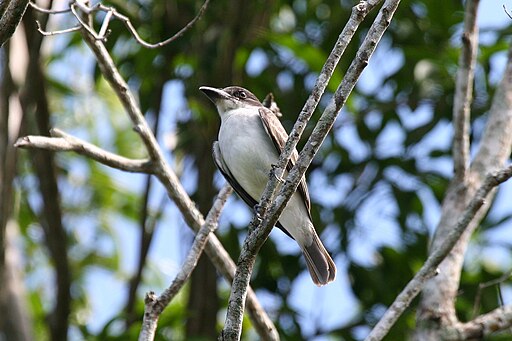Superregnum: Eukaryota
Regnum: Animalia
Subregnum: Eumetazoa
Cladus: Bilateria
Cladus: Nephrozoa
Superphylum: Deuterostomia
Phylum: Chordata
Cladus: Craniata
Subphylum: Vertebrata
Infraphylum: Gnathostomata
Superclassis: Tetrapoda
Cladus: Reptiliomorpha
Cladus: Amniota
Classis: Reptilia
Cladus: Eureptilia
Cladus: Romeriida
Subclassis: Diapsida
Cladus: Sauria
Infraclassis: Archosauromorpha
Cladus: Crurotarsi
Divisio: Archosauria
Subsectio: Ornithodira
Subtaxon: Dinosauromorpha
Cladus: Dinosauria
Ordo: Saurischia
Cladus: Eusaurischia
Cladus: Theropoda
Cladus: Neotheropoda
Infraclassis: Aves
Ordo: Passeriformes
Subordo: Tyranni
Infraordo: Tyrannides
Parvordo: Tyrannida
Familia: Tyrannidae
Subfamilia: Tyranninae
Genus: Tyrannus
Species: Tyrannus cubensis
Name
Tyrannus cubensis Richmond, 1898
Type locality: Cuba
Synonyms
Tyrannus magnirostris d’Orbigny, 1839 (preocc.)
References
Richmond, C.W. 1898. General Notes: Tyrannus magnirostris d’Orb. Renamed The Auk 15(4): p.330 BHL.Reference page.
d’Orbigny, A. 1839. Aves. In Sagra, R. de la. Historia física, política y natural de la isla de Cuba. 2a. Parte. Historia Natural. Arthus Bertrand. Paris. 3: 1–220 DOI: 10.5962/bhl.title.207 BHL Reference page. Original description p. 69 BHL pl. 13
Links
IUCN: Tyrannus cubensis (Endangered)
Vernacular names
العربية: عصفور الملك العملاق
català: Tirà cubà
Cymraeg: Teyrnaderyn mawr
English: Giant kinbird
español: Tirano cubano
فارسی: شاهمرغ بزرگ
suomi: Isotyranni
français: Tyran géant
magyar: Kubai királygébics
Nederlands: Cubaanse koningstiran
svenska: jättekungstyrann
The giant kingbird (Tyrannus cubensis) is a species of bird in the tyrant flycatcher family Tyrannidae. It is endemic to Cuba, although there are historical records of it on other islands. The species is probably mostly closely related to the loggerhead kingbird, which also occurs in Cuba as well as several other nearby Caribbean islands.[2]
While this species has been reported in the past to average only 23 cm (9 in) long,[3] this may be excessively conservative with the overall length being 23 to 26 cm (9.1 to 10.2 in).[4] Although it is not the largest tyrant flycatcher, its body mass was reported is significantly higher than the next largest known kingbird, the thick-billed kingbird, with an average of 93.6 g (3.30 oz), sometimes scaling up to 108 g (3.8 oz), meaning it can be nearly as heavy as the largest tyrant flycatcher, the great shrike tyrant.[5] The giant kingbird is found in tall lowland forest. In particular it favours pine forests and the wooded borders of waterways. It is also found in mixed pine barrens, open woodlands, swamps and savanna. It has also been seen in cloud forest.[2]
It is threatened by habitat loss.
References
BirdLife International (2020). "Tyrannus cubensis". IUCN Red List of Threatened Species. 2020: e.T22700516A179476365. doi:10.2305/IUCN.UK.2020-3.RLTS.T22700516A179476365.en. Retrieved 12 November 2021.
Mobley, Jason A. (2004), "Family Tyrannidae (tyrant flycatchers)", in del Hoyo, Josep; Elliott, Andrew; Christie, David (eds.), Handbook of the Birds of the World. Volume 9, Cotingas to Pipits and Wagtails, Barcelona: Lynx Edicions, pp. 424, ISBN 84-87334-69-5
http://www.birdlife.org/datazone/speciesfactsheet.php?id=4418
Mobley, J. A. and C. J. Sharpe (2020). Giant Kingbird (Tyrannus cubensis), version 1.0. In Birds of the World (J. del Hoyo, A. Elliott, J. Sargatal, D. A. Christie, and E. de Juana, Editors). Cornell Lab of Ornithology, Ithaca, NY, USA.
Dunning, John B. Jr., ed. (2008). CRC Handbook of Avian Body Masses (2nd ed.). CRC Press. ISBN 978-1-4200-6444-5.
Retrieved from "http://en.wikipedia.org/"
All text is available under the terms of the GNU Free Documentation License


